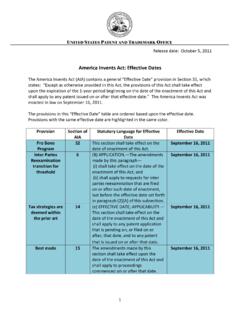Transcription of FAQs on the 2013 Sequestration
1 faqs on the 2013 Sequestration On Monday, April 1, a 2 percent across-the-board cut in Medicare provider payments will take effect . The Sequestration is required by the Budget Control Act that was signed into law in August 2011. It was originally intended as an incentive for the so-called Super Committee convened that year to design an alternative package to achieve $ trillion in budget savings. How will Medicare physician payments be affected? All Medicare physician claims with a date of service on or after April 1 will be subject to a 2 percent payment cut. Costs for physician-administered drugs included on the physician claim will also be subject to the 2 percent cut. The cut will be applied to the payment itself, not the underlying allowed charge in the Medicare fee schedule. As a result, beneficiary copayments and deductibles will not change. In other words, the 2 percent cut is imposed only on the 80 percent of the allowed charge that a participating physician would receive directly from Medicare.
2 The 20 percent copayment amount (and any deductible) that the physician collects from the patient will be based on the full allowed charge amount. With respect to unassigned claims for services provided by nonparticipating physicians, the 2 percent cut will be applied to the Medicare payment made to the beneficiary (but not to the limiting charge amount). How will Medicare payments to other providers be affected? Hospitals, home health services, durable medical equipment suppliers, and all others who provide services to Medicare patients will receive the same 2 percent payment cut for dates of discharge, rental agreements, etc., beginning on or after April 1. This reduction will also affect Medicare direct and indirect graduate medical education payments. How are other (non-Medicare) programs being affected? The Budget Control Act specifies that half the budget savings must be achieved through defense spending cuts.
3 Medicare provider cuts are limited to 2 percent, so the lion s share of the non-Defense savings will come at the expense of domestic discretionary programs. The $ billion in 2013 sequester savings breaks down as follows: o percent cuts in defense spending, for a savings of $43 billion o A percent reduction in domestic discretionary spending, for savings of $29 billion o 2 percent cuts in Medicare provider payments that will save about $10 billion o A percent cut to defense and non-defense mandatory programs to save about $4 billion Page 2 Certain safety net programs, including Medicaid, are exempt from the cuts, as are military personnel salaries. The precise impact on specific public health and other programs will vary, although staff furloughs are being implemented by many federal agencies. The savings targets for the defense and domestic discretionary programs are based on the federal fiscal year, which began October 1, so the impact severity for the remainder of FY 2013 depends on what steps individual agencies and programs may have taken since last October to reduce spending.
4 How long will the Sequestration last? The Budget Control Act requires that $ trillion in federal spending cuts be achieved over the course of nine years. So, unless Congress takes action to change the law, federal spending will be subject to Sequestration until 2022. Because the American Taxpayer Relief Act that was signed into law in January delayed the 2013 sequester for two months (with a budget offset), the Defense and discretionary program cuts are less severe now than they will be in coming years. As an entitlement program, the Medicare payment cut is treated a little differently than the cuts being imposed on programs subject to the appropriations process. The Medicare cut will never be higher than 2 percent. Importantly, the Medicare cuts each year are not cumulative. So, the 2 percent cut this year will not be followed by another 2 percent cut next year, and so forth, producing a cumulative double-digit cut at the end of the Sequestration period.
5 In other words, this year s 2 percent cut will simply remain in place every year through 2022 (unless Congress takes action to stop it). What are the prospects of Congressional action to stop the sequester? With all the fiscal deadlines facing Congress this year, the sequester will remain a subject for debate. However, we are mid-way through the fiscal year and, barring a major backlash, it is expected that the sequester cuts will remain in effect through at least Sept 30, 2013 . The future of Sequestration beyond 2013 is likely to depend on whether or not Congress and the White House are able to reach a new budget agreement to address deficit and spending concerns. What has the AMA done to address the sequester? The AMA initiated a campaign last fall to educate Members of Congress about the negative consequences of Sequestration . In addition to repeated direct communications with Congressional offices, the AMA took the following actions: o We cosponsored a study and media event with the American Hospital Association and the American Nurses Association, detailing the impact that the cuts will have on employment in the health care sector, including employees in Page 3 physician practices, over the course of the nine year sequester.
6 Joint advertisements were placed in inside-the-beltway publications highlighting the study s findings. o We organized two letters to Congress, cosigned by Federation groups, explaining the impact that Sequestration will have on practices, on patients, and on health care programs generally. o We activated our patient and physician grassroots networks. Information about these activities is posted on the AMA web site, at We encourage physicians to contact their Representatives and Senators emphasizing the impact of the Medicare program s instability on their practices and their patients, using the support material that is routinely updated and posted on the AMA s web site.





![Acquired [Seller] 23 January 2018 Germany GEA Group AG ...](/cache/preview/9/8/a/a/8/b/d/0/thumb-98aa8bd0a0013efe1cbe17d4a05a2d50.jpg)


